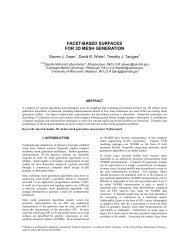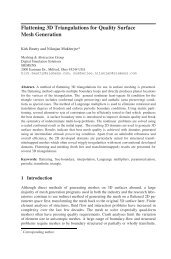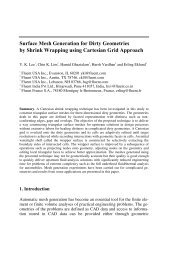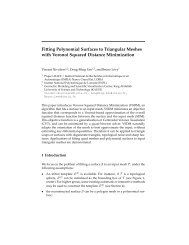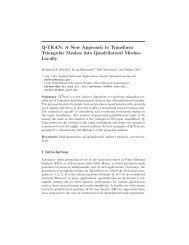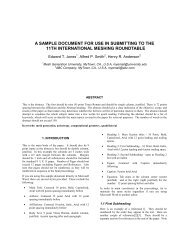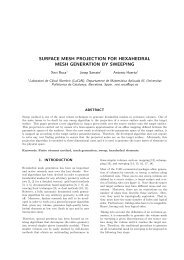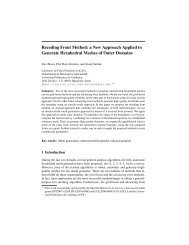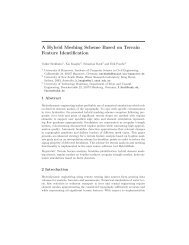CPU-GPU Algorithms for Triangular Surface Mesh Simplification
CPU-GPU Algorithms for Triangular Surface Mesh Simplification
CPU-GPU Algorithms for Triangular Surface Mesh Simplification
You also want an ePaper? Increase the reach of your titles
YUMPU automatically turns print PDFs into web optimized ePapers that Google loves.
<strong>CPU</strong>-<strong>GPU</strong> <strong>Algorithms</strong> <strong>for</strong> <strong>Triangular</strong> <strong>Surface</strong> <strong>Mesh</strong> <strong>Simplification</strong> 15cation rates <strong>for</strong> per<strong>for</strong>ming 10 iterations of the algorithm on the bunny andgargoyle meshes can be seen in Tables 5 and 6, respectively.(a) Bunny(b) GargoyleFig. 8. The resulting meshes after three iterations of the <strong>CPU</strong>-<strong>GPU</strong> inverse reductionalgorithm.The simplification rate <strong>for</strong> both vertices and faces after 10 iterations of thealgorithm hovers around 57% to 63%. After three iterations, there are visibleareas where repeated simplification occurred on the bunny mesh as shown inFigure 8, but this is not the case on the larger meshes. After 10 iterations, thebunny, horse, and kitten meshes exhibit an extreme loss of detail, as shown inFigure 9. The armadillo lost some detail in the head; the other meshes do notshow too much loss of detail. This suggests that the larger a mesh is initially,the more that it can be simplified without any visible negative effects.Table 7 shows the simplification percentages as a function of the numberof iterations <strong>for</strong> the vertices and faces in each mesh. The simplification percentagesincrease at a decreasing rate. This suggests that as a mesh increasesin size, the decrease in running time achieved by using the <strong>GPU</strong> simplificationalgorithm instead of the <strong>CPU</strong> simplification algorithm increases as well.4 Conclusions and Future WorkIn this paper, we have proposed two lossless <strong>CPU</strong>-<strong>GPU</strong> surface mesh simplificationalgorithms. Our algorithms are based on the <strong>GPU</strong> marking algorithm,which uses multiple <strong>GPU</strong> threads to concurrently mark elements as affected,and the <strong>GPU</strong> inverse reduction algorithm, which attempts to per<strong>for</strong>m theedge-collapse operation on twice as many edges at each step compared to <strong>GPU</strong>marking algorithm. Both algorithms were tested on numerous triangular surfacemeshes from computer graphics. The combinations of the <strong>CPU</strong> algorithmwith the two <strong>GPU</strong> algorithms are novel. In particular, the <strong>CPU</strong>-<strong>GPU</strong> algorithmsleverage the concurrency of the <strong>GPU</strong> to accelerate the simplification ofour surface meshes. The algorithms can be used in various areas of computergraphics, such as video games and computer imaging, where there is a clearbenefit in creating a series of meshes from a single source mesh or a simplified



